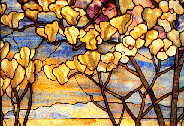

 Glass
is composed of silica sand, lime, and soda, plus other materials that alter its
color and other characteristics. Glass may be clear or opaque, depending on the
mixture and methods used. It also varies greatly in its density, fragility, and
ability to tolerate heat and cold. All of these variables make it an invaluable
material for both domestic and industrial applications. Its beauty has also inspired
many craftsmen to create marvelous works of art.
Glass
is composed of silica sand, lime, and soda, plus other materials that alter its
color and other characteristics. Glass may be clear or opaque, depending on the
mixture and methods used. It also varies greatly in its density, fragility, and
ability to tolerate heat and cold. All of these variables make it an invaluable
material for both domestic and industrial applications. Its beauty has also inspired
many craftsmen to create marvelous works of art.
The oldest examples of glass date to about 2000 BC, and were found in Egyptian tombs. Glass was made by the Phoenicians (who lived in what is now Lebanon) from an early date.
The classic method of forming glass was to blow the molten glass, by catching a blob of the heated glass on the end of a pipe, and shape it to the desired form by blowing through the pipe, and shaping it with various tools. The glass could also be blown into a mold.
Colored glass is created by the addition of minerals to the molten glass. For example, gold was used in the past to create red; cobalt for blue; and manganese for purple. Ancient glass found in burial sites often has an iridescent surface that results from chemical reactions that occurred with the soil. In the late 19th century glass craftsmen sought to duplicate this effect in new glass. Iridescent effects were used by the Art Nouveau glassmakers such as Louis Comfort Tiffany and Emile Galle.
Glass can also be embellished in the same ways as wood and metal. It can be carved, cut, etched, and engraved. It may also be sandblasted and fused, a means of appliqueing layers of glass. Modern glass artists frequently mix techniques of construction, coloring, and surface finishing to achieve spectacular effects.
 Stained glass making is a technique of collage, in which pieces
of differently colored glass are cut to the shapes of a design, and fitted together.
The glass is colored either by the mixture of certain oxides or minerals with
the molten glass, or by firing these colorants onto the surface of clear glass.
The advantage of the latter method is that the colorants can be painted onto
the glass to create a picture or design.
Stained glass making is a technique of collage, in which pieces
of differently colored glass are cut to the shapes of a design, and fitted together.
The glass is colored either by the mixture of certain oxides or minerals with
the molten glass, or by firing these colorants onto the surface of clear glass.
The advantage of the latter method is that the colorants can be painted onto
the glass to create a picture or design.
The most well known method of holding the pieces together is the use of lead joining strips. However, other materials such as copper and plaster have also been used for the joining. Stained glass windows probably originated in the Middle East, where glassmaking also originated. Fine early examples can be seen in the mosques and palaces of India, Iran and Turkey. In Europe stained glass was first used in the windows of the great cathedrals in Germany, beginning in the 11th century. It has been associated with church architecture since the middle ages.
Beginning in the 19th century stained glass became more common in secular structures. The windows of Louis Comfort Tiffany were particularly noted for their naturalistic effects, achieved through the use of multi-colored, marbled glass. Tiffany and a French designer, Emile Galle were also known for their application of stained glass to the new forms of lighting - first gas, then electric lamps were sheltered under stained glass shades. Some of the most noteworthy examples of modern stained glass windows have been based on the designs of leading artists; one well known set of examples are the windows designed by Marc Chagall, including one at the United Nations building.
For more information about the techniques and history of glassmaking, contact the Corning Glass Museum site through this link. Better yet, take a one hour drive to Corning NY and visit the Museum and the Steuben glass works in person.
 |